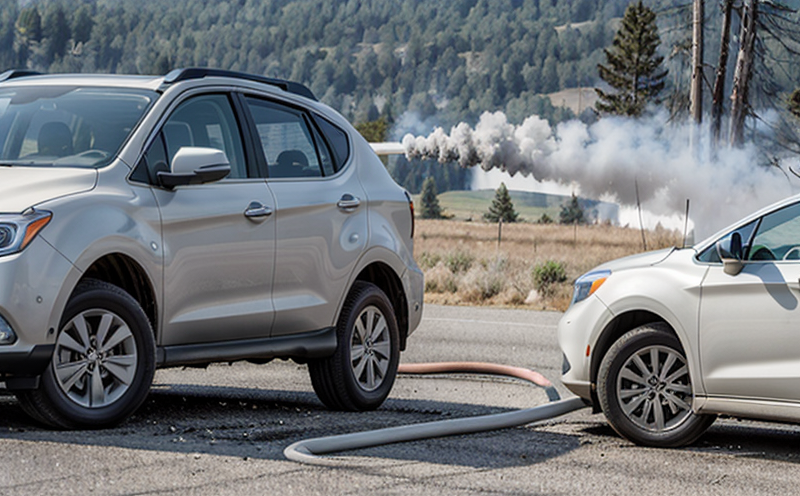ISO 5659-2 Smoke Generation Testing of Materials
The ISO 5659-2 standard is a pivotal framework in the fire safety testing sector, particularly relevant for materials that are suspected to contribute significantly to smoke and toxic gas emission during combustion. This service is critical for ensuring compliance with regulatory standards across various industries including automotive, aerospace, building construction, and consumer products.
The ISO 5659-2 protocol provides a standardized method for measuring the smoke production of solid materials under controlled laboratory conditions. The test simulates real-world fire scenarios where materials may be exposed to high temperatures or flames, thus generating smoke and potentially harmful gases. The primary objective is to determine the mass loss and optical density of the generated smoke, which are key indicators of a material's flammability characteristics.
During testing, specimens are subjected to controlled combustion in an oxygen-rich environment, with precise temperature and gas flow parameters. This process allows for accurate measurement of both the amount of smoke produced and its optical density, which can be directly correlated with the potential impact on human health and building structures during a fire event.
The test results provide valuable insights into material selection and design decisions, helping to enhance product safety and compliance. For instance, in the automotive industry, understanding smoke generation is crucial for preventing vehicle fires and ensuring that materials used do not compromise passenger safety. In construction, this information can guide the choice of fire-resistant materials that minimize smoke production.
Our laboratory adheres strictly to ISO 5659-2 guidelines to ensure consistent and reliable test results. We employ advanced instrumentation capable of capturing detailed data points throughout the testing process. This precision is essential for ensuring that our clients receive accurate, reproducible results that can be relied upon for regulatory submissions or internal quality assurance purposes.
For those seeking deeper insights into how this service impacts their operations, consider the following real-world applications:
- Automotive Industry: Ensuring seat covers and interior materials do not release excessive smoke during a fire event.
- Aerospace Sector: Selecting composite materials that minimize smoke generation to protect pilots and passengers in the event of cabin fires.
- Building Construction: Identifying fire-resistant cladding systems that do not contribute significantly to smoke.
- Consumer Products: Evaluating textiles used in bedding or furniture to ensure they meet strict smoke emission standards.
The ISO 5659-2 test is just one part of our comprehensive fire safety testing suite, designed to provide a holistic approach to material evaluation and certification. By integrating this service into your quality management system, you can enhance product safety while ensuring compliance with international standards.
Applied Standards
| Standard | Description |
|---|---|
| ISO 5659-2:2018 | This standard specifies the procedure for measuring smoke production from solid materials under controlled laboratory conditions. |
The ISO 5659-2 protocol is meticulously designed to provide consistent and reproducible results, ensuring that test outcomes are comparable across different laboratories. Compliance with this international standard ensures that your products meet the highest safety and quality standards demanded by regulatory bodies worldwide.
Eurolab Advantages
At Eurolab, we pride ourselves on offering comprehensive fire safety testing services tailored to your unique needs. Our ISO 5659-2 Smoke Generation Testing of Materials service is complemented by a suite of complementary tests that provide a holistic view of material performance under fire conditions.
- Advanced Instrumentation: Utilize state-of-the-art equipment for precise measurement and data analysis.
- Expertise: Our team comprises highly skilled engineers with extensive experience in fire safety testing.
- Comprehensive Reporting: Receive detailed reports that provide actionable insights into material performance.
- Regulatory Compliance: Ensure your products meet all relevant international standards and regulations.
We understand the importance of accurate, reliable testing in maintaining a competitive edge. By partnering with Eurolab for ISO 5659-2 Smoke Generation Testing, you can trust that your materials are rigorously evaluated to ensure optimal performance under fire conditions.
Environmental and Sustainability Contributions
- Promotes Safer Products: By minimizing smoke production, materials contribute to safer environments during fires.
- Emissions Reduction: Lowering the amount of toxic gases emitted helps protect public health and reduce environmental impact.
- Sustainable Material Selection: Ensures that only environmentally friendly materials are used in products.
The ISO 5659-2 Smoke Generation Testing service plays a crucial role in fostering sustainable practices within industries, thereby promoting safer and more responsible product development. By adhering to this standard, businesses can contribute positively to both human health and environmental preservation.





